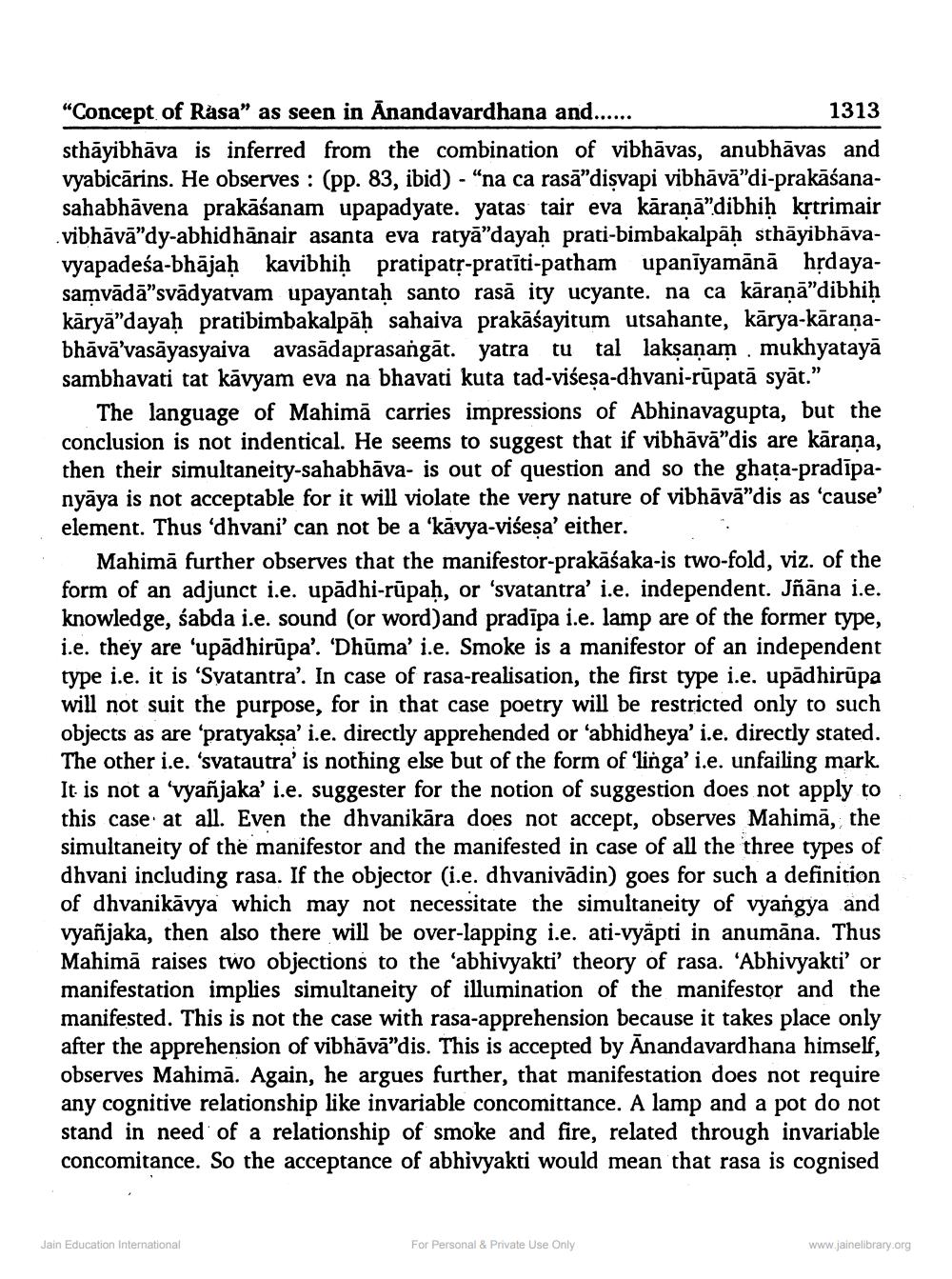________________
"Concept of Rasa" as seen in Anandavardhana and......
1313 sthāyibhāva is inferred from the combination of vibhāvas, anubhāvas and vyabicārins. He observes : (pp. 83, ibid) - "na ca rasā"dişvapi vibhāvā"di-prakāśanasahabhāvena prakāśanam upapadyate. yatas tair eva kāranā”dibhih krtrimair .vibhāvā"dy-abhidhānair asanta eva ratyā”dayaḥ prati-bimbakalpāḥ sthāyibhāvavyapadeśa-bhājah kavibhih pratipatr-pratiti-patham upanīyamānā hrdayasamvādā"svādyatvam upayantaḥ santo rasā ity ucyante. na ca kāraṇā"dibhih kāryā”dayaḥ pratibimbakalpāḥ sahaiva prakāśayitum utsahante, kārya-kāraņabhāvā'vasāyasyaiva avasādaprasangāt. yatra tu tal lakṣaṇam, mukhyatayā sambhavati tat kāvyam eva na bhavati kuta tad-vićeșa-dhvani-rūpatā syāt.”
The language of Mahimā carries impressions of Abhinavagupta, but the conclusion is not indentical. He seems to suggest that if vibhāvā"dis are kārana, then their simultaneity-sahabhāva- is out of question and so the ghața-pradīpanyāya is not acceptable for it will violate the very nature of vibhāvā"dis as 'cause' element. Thus 'dhvani' can not be a 'kāvya-viseșa' either. .:
Mahimā further observes that the manifestor-prakāśaka-is two-fold, viz. of the form of an adjunct i.e. upādhi-rūpah, or 'svatantra' i.e. independent. Jñāna i.e. knowledge, sabda i.e. sound (or word)and pradīpa i.e. lamp are of the former type, i.e. they are 'upādhirūpa'. 'Dhūma' i.e. Smoke is a manifestor of an independent type i.e. it is 'Svatantra'. In case of rasa-realisation, the first type i.e. upadhirūpa will not suit the purpose, for in that case poetry will be restricted only to such objects as are 'pratyakşa' i.e. directly apprehended or 'abhidheya' i.e. directly stated. The other i.e. 'svatautra' is nothing else but of the form of 'linga' i.e. unfailing mark. It is not a 'vyañjaka' i.e. suggester for the notion of suggestion does not apply to this case at all. Even the dhvanikāra does not accept, observes Mahimā, the simultaneity of the manifestor and the manifested in case of all the three types of dhvani including rasa. If the objector (i.e. dhvanivādin) goes for such a definition of dhvanikāvya which may not necessitate the simultaneity of vyangya and vyañjaka, then also there will be over-lapping i.e. ati-vyāpti in anumāna. Thus Mahimā raises two objections to the 'abhivyakti' theory of rasa. 'Abhivyakti' or manifestation implies simultaneity of illumination of the manifestor and the manifested. This is not the case with rasa-apprehension because it takes place only after the apprehension of vibhāvā"dis. This is accepted by Anandavardhana himself, observes Mahimā. Again, he argues further, that manifestation does not require any cognitive relationship like invariable concomittance. A lamp and a pot do not stand in need of a relationship of smoke and fire, related through invariable concomitance. So the acceptance of abhivyakti would mean that rasa is cognised
Jain Education International
For Personal & Private Use Only
www.jainelibrary.org




